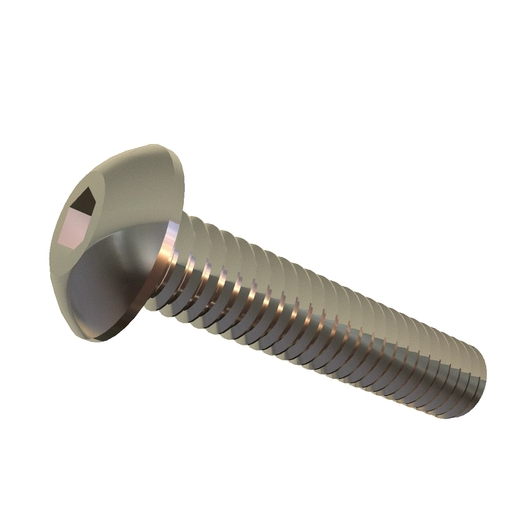The Ultimate Guide to Fastener Heads: Understanding the Types and Applications
Last updated on January 14, 2025 11:30:00 AM
Fasteners are the unsung heroes of countless industries, providing the mechanical strength to hold structures, devices, and machinery together. To learn about fastener types, take a look at our previous blog. In this guide, we will discuss a crucial aspect of choosing the right fastener by understanding the various types of fastener heads. Each type serves specific purposes, offering unique functional and aesthetic qualities.
Figure 1. Fastener head types.
1. Pan Head
Pan head fasteners have a slightly rounded top with a flat bearing surface underneath. Their design provides a clean and neat appearance, making them ideal for applications where the fastener will be visible. Pan heads are commonly used in:
- Electronics
- Light-duty mechanical assemblies
- Furniture construction
2. Flat Head
Flat head fasteners are designed to sit flush with the surface of the material. Their countersunk shape ensures a smooth finish, making them perfect for applications where aesthetics or surface uniformity is critical. Typical uses include:
- Woodworking
- Cabinet making
- Construction
3. Fillister Head
Fillister heads are cylindrical with a slightly rounded top. They have a smaller diameter than round heads and a taller head height, allowing for deeper drive engagement. Fillister screws are often found in:
- Electrical components
- Machinery requiring high torque
- Precision instruments
4. Truss Head
Truss heads have a wide, low-profile design that distributes force over a larger area. Their shape minimizes material deformation and is well-suited for thin materials. Applications include:
- Sheet metal work
- Plastic assembly
- HVAC systems
5. Round Head
Round head fasteners feature a domed top with a flat bearing surface. They are often used in vintage-style hardware and applications requiring a decorative finish. Common uses include:
- Automotive restoration
- Decorative hardware
- Electrical wiring clamps
6. Oval Head
Oval head fasteners combine the benefits of flat and round heads. They are partially countersunk but retain a decorative, rounded appearance. These are commonly used in:
- Marine hardware
- Door hinges
- Light fixtures
7. Cheese Head
Cheese head screws have a cylindrical shape with a flat top and only available in metric sizes. The name comes from their resemblance to a wheel of cheese. These fasteners are commonly used in:
- Electronics
- Industrial machinery
- Applications requiring a deep slot for torque
8. Socket Head
Socket head fasteners are cylindrical with a recessed hexagonal drive, allowing for high torque application. Their compact design makes them ideal for applications with limited space. Common uses include:
- Robotics
- Automotive assemblies
- High-strength applications
9. Binding Head
Binding heads are low-profile and feature a large, flat bearing surface. They are often used in applications where materials need to be clamped without damage. Examples include:
- Bookbinding
- Electrical connectors
- Leatherwork
10. Hex Head
Hex head fasteners are characterized by their six-sided heads, which allow for easy tightening with a wrench. They are a staple in construction and heavy-duty applications, such as:
- Structural framing
- Machinery assembly
- Automotive repair
11. Hex Flange Head
Hex flange heads incorporate a built-in washer under the hex head, which helps distribute load and resist loosening. These are commonly used in:
- Automotive assemblies
- Heavy machinery
- Construction equipment
12. Hex Washer Head
Similar to hex flange heads, hex washer heads include a built-in washer for added stability. They are commonly used in:
- Roofing
- Sheet metal fastening
- Outdoor applications
13. Cup Washer Head
Cup washer heads are unique in that the finished copper washer is incorporated into the screw design, offering a neat and polished appearance. They are often used in:
- Decorative hardware
- Furniture assembly
- Marine applications
14. Button Head
Button head fasteners feature a low-profile, rounded top with a wide bearing surface. Their sleek design is ideal for applications requiring a smooth finish. Common uses include:
- Bicycle components
- Electronics enclosures
- Industrial equipment
 Choosing the Right Fastener Head
Choosing the Right Fastener Head
When selecting a fastener, consider the following factors:
- Application requirements: Does the fastener need to be countersunk, decorative, or high-strength?
- Material compatibility: Ensure the head design won’t damage or deform the material.
- Aesthetics: For visible fasteners, choose a head type that complements the overall design.
Understanding these fastener head types can help you make informed decisions for your projects, ensuring both functionality and visual appeal. Whether you're assembling furniture, constructing machinery, or crafting precision instruments, the right fastener head makes all the difference.




